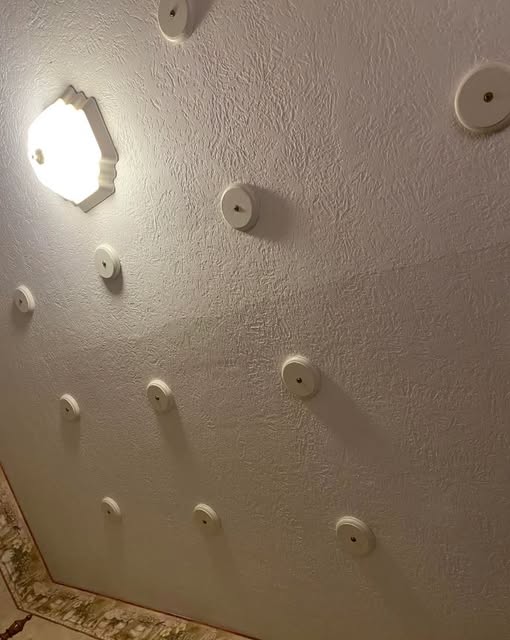While lying in a hotel room after a tiring trip, I noticed something unusual on the ceiling—small wooden discs arranged in a neat grid. At first, I thought they might be leftover parts of a chandelier or some strange sound system, but then I remembered seeing these before in older buildings. They’re actually a clever old-fashioned way to fix sagging plaster ceilings.
 Before drywall became popular, builders used lath and plaster to make walls and ceilings. Thin wooden strips called lath were nailed to the frame, and wet plaster was applied over them. The plaster would seep between the slats and harden, creating a solid surface. But over time, plaster dries out and cracks, eventually pulling away from the lath and sagging—or even falling in chunks.
Before drywall became popular, builders used lath and plaster to make walls and ceilings. Thin wooden strips called lath were nailed to the frame, and wet plaster was applied over them. The plaster would seep between the slats and harden, creating a solid surface. But over time, plaster dries out and cracks, eventually pulling away from the lath and sagging—or even falling in chunks.
You might think the best fix is to just screw the plaster back up, but it’s too fragile and would break. Instead, these wooden discs—about the size of a silver dollar—are screwed through the plaster into the lath, spreading the pressure and pulling the plaster back without cracking it. It’s a simple, effective solution that’s lasted for decades.
I tried this myself years ago in a 1920s bungalow with a sagging ceiling. I drilled holes and screwed in wooden discs in a checkerboard pattern, then painted over it. The ceiling stayed solid for years. It’s not glamorous, but it works and adds character.
If you see these discs in just one room, it might mean that area had worse plaster damage, or maybe it suffered water damage from above. Old buildings tell stories, and these discs are part of that history.
Some people leave the discs visible for a vintage look, while others cover them with plaster and paint. I like seeing them—they show a hands-on fix and a respect for preserving the past.
So, if you spot these wooden circles on your ceiling, don’t worry—they’re not strange decorations but a practical repair from days gone by. It’s a reminder that sometimes old solutions are the best ones.
Beta feature

